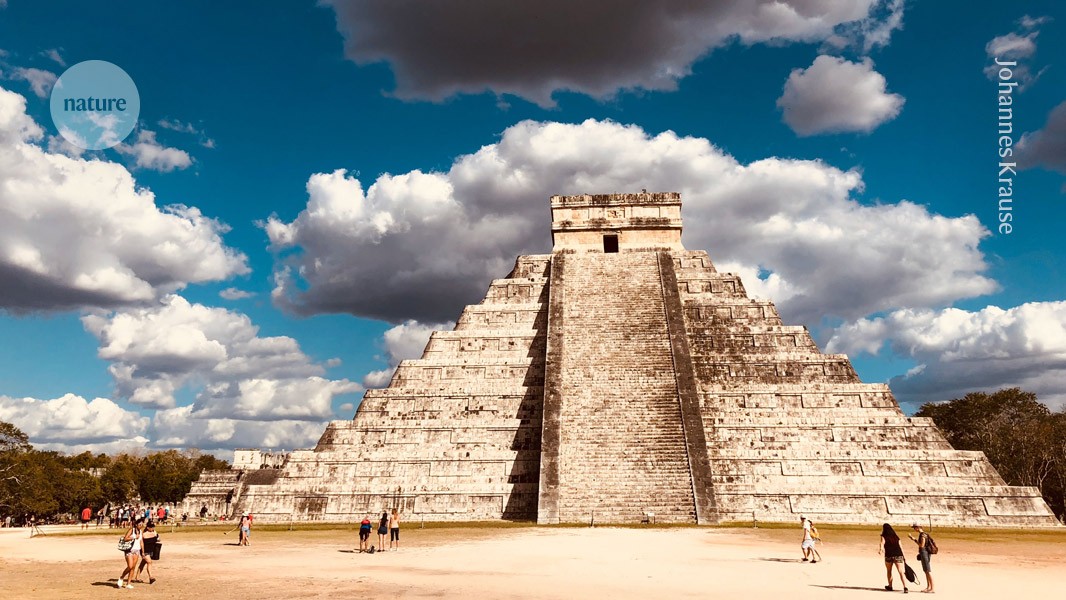Ancient DNA from Maya ruins tells story of ritual human sacrifices

Children sacrificed at Chichén Itzá have genetic links to people living near the ancient Maya city in Mexico, and hint at the effects of colonial-era epidemics

The Temple of Kukulcan is the largest Mayan structure in the ceremonial centre of Chichén Itzá in present-day Mexico.Credit: Johannes Krause
The ruins of the Maya metropolis Chichén Itzá are filled with signs of ritual sacrifice. An engraving near the ancient city’s famous ballcourt depicts a severed head, blood spurting out. The remains of hundreds of victims have been recovered from the Sacred Cenote, a 60-metre-wide sinkhole.
Now, ancient DNA from some of the city’s youngest victims adds to this story. A study published today in Nature analysed genomes from skulls of dozens of children and babies recovered from an underground chamber at the site in modern Mexico. It found that they were all boys, and a surprising number were close relatives, including identical twins1.
“This was very, very astonishing,” says study co-author Oana Del Castillo-Chávez, a biological anthropologist at the Yucatán National Institute of Anthropology and History in Mérida, Mexico. Remains from the Sacred Cenote included those of boys and girls, and there is no evidence from Chichén Itzá or other ancient Maya cities of close relatives being sacrificed, she adds.
The young victims in the current study are closely related to people now living near Chichén Itzá, whose genomes carry changes potentially linked to their ancestors’ exposure to epidemics in the 16th century.
Regular sacrifices
Chichén Itzá was one of the most important cities in ancient Maya civilization, especially between ad 800 and 1000, when other regions were in decline. Ritual child sacrifice seems to have been a regular event at Chichén Itzá, but many aspects of the practice remain unclear.
The children Del Castillo-Chávez and her colleagues analysed were found in the 1960s in an underground chamber called a chultún and an adjacent cave, near the Sacred Cenote. The remains showed no signs of violence, but they were found as part of a shrine, now destroyed by construction work.

A section of the reconstructed stone tzompantli, or skull rack, at Chichén Itzá.Credit: Johannes Krause
In the hope of identifying the sex of the remains and to glean other genetic insights, Del Castillo-Chávez teamed up with immunogeneticist Rodrigo Barquera and palaeogeneticist Johannes Krause at the Max Planck Institute for Evolutionary Anthropology in Leipzig, Germany, and their colleagues. The team obtained ancient genome data from the skulls of 64 of the roughly 106 individuals buried at the chultún.
The children were sacrificed between the seventh and mid-twelfth century ad, radiocarbon dating suggested. In addition to revealing that all the victims were boys, the genome data showed that one-quarter had a first- or second-degree relative — probably a sibling or cousin — in the chultún, including two pairs of identical twins. The presence of twins and close relatives could be linked to rituals that involved twin figures from Mayan mythology avenge , the researchers suggest.
Victim profiles
It’s not fully clear why these children were selected for sacrifice. Isotopic analysis of their bones suggested that their plant-heavy diets — probably maize (corn) — were typical of ancient Maya. Related individuals tended to have similar isotopic profiles, suggesting that they were raised in a similar way.
“Probably it was part of preparing them for this sacrifice,” says Barquera, who is from Mexico. “Death and sacrifice for them means something completely different to what it means to us. For them, it was a big honour to be part of this.”

Carvings on the stone tzompantli depict human skulls.Credit: Christina Warinner
The children from the chultún belonged to the same genetic population as present-day Maya people from a village near Chichén Itzá called Tixcacaltuyub. But this doesn’t necessarily mean they were locals, the researchers say. Many of the sacrificed people from the Sacred Cenote grew up far from the Yucatán Peninsula2. Previously, Del Castillo-Chávez and her colleagues found that the shape of the victims’ teeth was distinct from that of people from other ancient Maya sites, and proposed that the sacrificed individuals belonged to a group of long-distance traders who had settled in Chichén Itzá3.
“The ancient Maya did a lot of profiling of victims in their ritual liturgies,” says Vera Teisler, a bioarchaeologist at the Autonomous University of Yucatán in Mérida, so it’s not surprising to her that select groups — in this case closely related boys — were part of the ceremonies linked to the chultún remains.
Early epidemics
The children’s genomes, which are the first from Maya people that pre-date the arrival of Europeans, also offer clues to how colonial-era epidemics affected Indigenous Mexicans. The researchers found that some versions of genes involved in recognizing pathogens — called HLA alleles — have become more common in modern Maya, whereas others have grown rarer. This could be evidence of natural selection.
An HLA allele that has become more than twice as common has been linked to protection against severe Salmonella infections. A previous study from Krause’s team has linked the bacterium Salmonella enterica sp. Paratyphi to a sixteenth-century disease outbreak called the cocoliztli epidemic4, which killed millions of people in Mexico and beyond.
But María Ávila Arcos, a palaeogenomicist at the National Autonomous University of Mexico in Mexico City, is “still not convinced” that S. enterica Paratyphi was behind cocoliztli, or by evidence that the epidemic caused a large shift in the abundance of certain HLA alleles. Demographic changes, such as a crash in the number of Indigenous people due to other factors, could cause similar changes in the absence of natural selection, she says.
Teisler hopes the study will reveal how more than 1,000 years of upheaval have shaped the genomes of contemporary Maya. “This study is decisively new,” she says, and “a cornerstone for more intricate inquiries about the convoluted trajectory of the Maya”.
doi: https://doi.org/10.1038/d41586-024-01759-1
This story originally appeared on: Nature - Author:Ewen Callaway


















